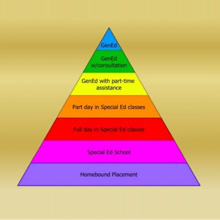What Does the Least Restrictive Environment (LRE) Mean?
The least restrictive environment (LRE) is a legal term found within 20 U.S.C. 1412(a)(5) of the Individuals with Disabilities Education Act (IDEA). The LRE provision of the IDEA provides that: “To the maximum extent appropriate, children with disabilities, including children in public or private institutions or other care facilities, are educated with children who are not disabled, and special classes, separate schooling, or other removal of children with disabilities from the regular educational environment occurs only when the nature or severity of the disability of a child is such that education in regular classes with the use of supplementary aids and services cannot be achieved satisfactorily.” 20 U.S.C. § 1412(a)(5)(A).
LRE means that a child with a disability must be educated within the same classroom as typical mainstreamed non-disabled peers to the fullest extent possible in order to ensure that a disabled child is receiving a free appropriate public education (FAPE). Historically speaking, prior to the enactment of the IDEA, children with disabilities were segregated and separated from mainstream typical classroom environments.
The key terms to underscore within the LRE provision of the IDEA is “to the maximum extent appropriate.” This means that the level of LRE a disabled child should receive is unique to the student’s individual needs and disability. LRE must be tied to the child’s individualized academic programming and instruction. Thus, special classes, a separate school or the removal of the child from the general mainstreamed classroom should only occur “when the nature or severity of the disability of a child is such that education in regular classes with the use of supplementary aids and services cannot be achieved satisfactorily.” Id.
Different Types of LRE
Not all LRE cases are straightforward and the IDEA does not specifically spell out what the LRE for each type of disability should look like. Understandably so, what LRE may look like for one child with a disability is not what it will look like for another. The primary intention of the LRE provision is to ensure that a child that is receiving a special education gets included in the general education classroom environment as often and frequent as possible. Practically speaking, LRE can be divided into a few different types of examples:
- General education classroom with supports. Your child spends the entire day in a general education class. He receives supports and services like a tutor or aide, assistive technology, related services, accommodations, modifications or any other combination of these.
- Partial mainstream/inclusion classroom. Your child spends part of the day in a general education class. He gets some individual or small-group instruction in a special education class or is pulled out of class for some services.
- Special education class. This is a program with specialized instruction for kids with similar learning needs.
- Specialized program outside of your school district. This includes private schools, residential programs and hospital programs.
Understanding the various levels of LRE will help ensure your child receives the most ambitiously appropriate educational experience within the least restrictive environment.
About the Author: Jeffrey L. Forte practices special education law, child advocacy and juvenile defense. He is the founding member of Forte Law Group LLC where he exclusively represents families and children with special needs. Forte Law Group LLC has offices in Westport, Shelton and Rocky Hill, Connecticut. For more information visit www.fortelawgroup.com




